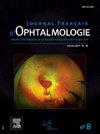Physiopathologie et prise en charge des kératites herpétiques liées aux virus herpes simplex résistants à l’aciclovir
IF 1.2
4区 医学
Q3 OPHTHALMOLOGY
引用次数: 0
Abstract
Les kératites herpétiques (KH) causées par le virus herpes simplex 1 (HSV-1) représentent la cause principale de cécité d’origine infectieuse dans les pays développés. Le traitement actuel repose sur l’usage curatif et préventif d’analogues nucléosidiques acycliques (ANA) anti-herpétiques, en particulier, l’aciclovir (ACV) ou d’autres molécules de même mode d’action. Les KH causées par un virus résistant à l’ACV sont de plus en plus rencontrées en pratique clinique. Leur prise en charge repose sur l’obtention du diagnostic virologique de résistance sur prélèvement oculaire acheminé en laboratoire spécialisé. La caractérisation génotypique par séquençage ADN des enzymes virales cibles des antiviraux permet l’adaptation thérapeutique en fonction de la mutation identifiée. Les mutations de la thymidine kinase (TK) virale sont les plus fréquentes et ne laissent que peu d’alternatives viables pour un traitement prophylactique au long cours parmi les molécules actuellement disponibles sur le marché. L’aménamévir (AMNV), nouvelle molécule ciblant le complexe d’enzymes virales hélicase-primase (HP) et ayant fait ses preuves dans le traitement d’autres localisations herpétiques, a récemment montré son intérêt dans la prise en charge des KH résistantes à l’ACV. Son mécanisme d’action indépendant de la TK lui permet de conserver une activité en cas de résistance avérée à l’ACV.
Herpetic keratitis (HK) caused by herpes simplex virus 1 (HSV-1) is the major cause of infection-related blindness in developed countries. Current treatment is based on curative and preventive use of antiherpetic acyclic nucleoside analogues (ANAs), namely acyclovir (ACV) or other molecules with the same mechanism of action. The frequency of HK caused by acyclovir-resistant viruses is steadily increasing. Virological proof of resistance is obtained from an ocular sample sent to a specialized laboratory. Genotypic characterization by DNA sequencing of the viral enzymes targeted by antivirals allows adaptation of treatment according to the mutation identified. Mutations of the viral thymidine kinase (TK) are the most frequent and leave few viable alternatives for long-term prophylactic treatment among currently available drugs. Amenamevir (AMNV), a new drug targeting the viral helicase-primase (HP) enzyme complex, with proven efficacy for treatment of herpetic infections of other sites, has recently shown value in the management of ACV-resistant HK. Its TK-independent mechanism allows it to retain its antiviral activity even in cases of patient resistance to ACV.
求助全文
约1分钟内获得全文
求助全文
来源期刊
CiteScore
1.10
自引率
8.30%
发文量
317
审稿时长
49 days
期刊介绍:
The Journal français d''ophtalmologie, official publication of the French Society of Ophthalmology, serves the French Speaking Community by publishing excellent research articles, communications of the French Society of Ophthalmology, in-depth reviews, position papers, letters received by the editor and a rich image bank in each issue. The scientific quality is guaranteed through unbiased peer-review, and the journal is member of the Committee of Publication Ethics (COPE). The editors strongly discourage editorial misconduct and in particular if duplicative text from published sources is identified without proper citation, the submission will not be considered for peer review and returned to the authors or immediately rejected.

 求助内容:
求助内容: 应助结果提醒方式:
应助结果提醒方式:


